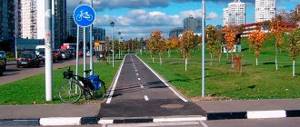Where can bike paths be built?
The standards for the design and construction of bicycle routes determine:
- SP 34.13330.2012 (formerly SNiP 2.05.02-85).
- SNiP II-K.3-62.
- GOST 33150-2014.
- SP 42.13330.2016 (updated edition of SNiP 2.07.01-89).
- VSN 25-86.
Single-lane pedestrian and bicycle paths on streets and parks
Bicycle paths can run along pedestrian sidewalks or on separate routes.
It is possible to build bicycle roads in green areas: city parks and forest parks. You can build cycling routes on embankments near rivers and seas. Their width is determined by standards.
Options for building bike paths:
- Separate road route.
- At the base of earthen embankments.
- On artificial embankments - berms.
Separate lanes for bicycles may be designated on roads. Their width is determined according to SP (SNiP), as well as GOST. The need for an additional lane arises if more than 100 cyclists pass on the road per hour. The traffic intensity should be up to 150 cars in 1 hour and up to 2000 cars in 24 hours.
Marking paths according to GOST
It is recommended to build single-lane roads on the windward side of the road. Two-lane - on both sides of the highway. (These are guidelines, not rules.)
The height of the curb that separates the bike path from the highway is 20–25 cm. When constructing a dividing strip, its width should be 0.7–1.5 m.
A bicycle lane on a sidewalk may be separate or accessible to pedestrians. Routes of the second type are called bicycle-pedestrian routes. The width of such a path is taken from 4 m.
12. All vehicles except mopeds are prohibited from using bicycle lanes. All vehicles are prohibited on pedestrian and bicycle paths. The traffic requirements for cyclists and moped drivers have changed significantly, so I present here the entire new text of Section 24 of the Traffic Rules:
"24.1. Cyclists over 14 years of age must use bicycle paths, bicycle pedestrian paths, or bicycle lanes.
24.2. Cyclists over the age of 14 are allowed to travel: on the right edge of the roadway - in the following cases: there are no bicycle and bicycle pedestrian paths, a lane for cyclists, or there is no opportunity to move along them; the overall width of the bicycle, its trailer or the cargo being transported exceeds 1 m; cyclists move in columns;
on the side of the road - if there are no bicycle and bicycle pedestrian paths, a lane for cyclists, or there is no opportunity to move along them or along the right edge of the roadway;
on a sidewalk or pedestrian path - in the following cases: there are no bicycle and bicycle pedestrian paths, a lane for cyclists, or there is no opportunity to move along them, as well as along the right edge of the roadway or shoulder; a cyclist accompanies a cyclist under 7 years of age or transports a child under 7 years of age on an additional seat, in a bicycle stroller or in a trailer designed for use with a bicycle.
24.3. The movement of cyclists aged 7 to 14 years should be carried out only on sidewalks, pedestrian, bicycle and pedestrian paths, as well as within pedestrian zones.
24.4. Cyclists under 7 years of age should only ride on sidewalks, pedestrian and bicycle paths (on the pedestrian side), as well as within pedestrian zones.
24.5. When cyclists move along the right edge of the roadway in the cases provided for by these Rules, cyclists must move only in one row. A column of cyclists may move in two rows if the overall width of the bicycles does not exceed 0.75 m. The column of cyclists must be divided into groups of 10 cyclists in the case of single-row traffic or into groups of 10 pairs in the case of double-lane traffic. To facilitate overtaking, the distance between groups should be 80 - 100 m.
24.6. If the movement of a cyclist on a sidewalk, pedestrian path, shoulder or within pedestrian zones endangers or interferes with the movement of other persons, the cyclist must dismount and follow the requirements provided for by these Rules for the movement of pedestrians.
24.7. Moped drivers must move along the right edge of the roadway in a single file or in the bicycle lane. Moped drivers are allowed to move along the side of the road if this does not interfere with pedestrians.
24.8. Cyclists and moped drivers are prohibited from: driving a bicycle or moped without holding the handlebars with at least one hand; transport cargo that protrudes beyond the dimensions by more than 0.5 m in length or width, or cargo that interferes with control; transport passengers if this is not provided for by the design of the vehicle; transport children under 7 years of age in the absence of specially equipped places for them; turn left or turn around on roads with tram traffic and on roads with more than one lane for traffic in a given direction; move on the road without a fastened motorcycle helmet (for moped drivers).
24.9. Towing of bicycles and mopeds, as well as towing with bicycles and mopeds, is prohibited, except for towing a trailer intended for use with a bicycle or moped.
24.10. When driving at night or in conditions of poor visibility, cyclists and moped drivers are recommended to carry items with reflective elements and ensure that these items are visible to drivers of other vehicles.”
Minimum width of a bicycle path in a park according to SNiP (SP)
The size of the bike lane depends on the volume of traffic. Construction codes and GOSTs regulating its width are presented in the table below.
| Bicycle path design | Bicycle path width according to GOST (m) | |
| In cramped conditions | When building from scratch | |
| Single-sided and single-lane | 0,75–1 | 1–1,5 |
| One-way and two-way | 1,5 | 1,75–2,5 |
| Two-way and two-lane (for oncoming traffic) | 2 | 2,5–3,6 |
The minimum width of a bicycle route is 0.75 m. This is the maximum minimum according to GOST 33150-2014, which determines the permissible lane size.
In the city
A two-lane bicycle path must be equal to or wider than 1.5 m. Two-way traffic is allowed with a traffic intensity of up to 70 bicycles in 1 hour. It is worth noting that the standard width of the route must be strictly observed in accordance with GOST.
Iconic designations
Sign 4.4.1, which shows a bicycle on a blue background, marks the beginning of a bicycle path. It is installed to the right of the traffic lane or above it. Experienced motorists should pay attention to the changed numbering of the sign from 4.4 to 4.4.1.
Sign 4.4.2 corresponds to the end of the dedicated lane for bicycles and mopeds; it looks like sign 4.4.1 crossed out with a red line.
“Cycle path” sign 4.4.1 “End of cycle path area” sign 4.4.2
When a bicycle road crosses a carriageway, the indicated sign is duplicated in the event of further continuation of the bicycle path. In this situation, on the side of the roadway, signs “Intersection with a bicycle path” 1.24 are installed, calling on car drivers to be extremely careful. When passing through such an intersection, the cyclist is obliged to:
- reduce speed;
- make sure the movement is safe;
- If it is necessary to carry out maneuvers, give a hand signal to other road users.
Sign 1.24 “Intersection with a bicycle path”
Nowadays, sidewalks are increasingly appearing along with the road for bicycles and are indicated by signs 4.5.2-4.5.7, and on some roads there are dedicated lanes for cyclists. Such sections of the road are indicated by signs 5.11.2, 5.13.3 and 5.13.4.
The “Bicycle in a red circle” sign indicates the impossibility of further travel on a bicycle. The citizen is advised to take a walking route or take a detour.
Sign 3.9 “No cycling”
Standards for distance to other objects
In parks, SNiP (SP) regulates not only the width of bicycle routes. The standards also define the minimum distances between separate bicycle paths and other objects (in meters):
- Sidewalk – 0.5.
- The edge of the road is 0.75.
- Trees – 0.75.
- Car parking – 1.5.
- Stopping any type of transport – 1.5.
Sketch of a single-lane bike path
Regulations for the construction of bicycle paths ensure the safety of cyclists.
They reduce the risk of serious injury if you lose control and fall off your bike. Rules for designing bicycle paths also ensure the safety of pedestrians. The width of these tracks is an important indicator.
When a bike path crosses a water hazard in a park or forest park, a bridge must be built. The height of fencing on a bridge over a ditch, stream or ravine should be 1.3 m or more, regardless of the width of the crossing.
Road intersection zones
Intersections should be located on a straight section of both routes. This should be an area with good visibility and minimal slope. At intersections, road signs are installed in accordance with traffic regulations.
Standard road width in the city according to SNiP and GOST standards
A traffic light must be installed at the intersection of the bicycle path and the highway. The road intersection area should be well illuminated with lanterns. The length of the illuminated section of the route should be from 60 m.
Road sign with a lane for cyclists
By analogy with a dedicated lane for public transport, directed towards the main flow, the rules now include signs indicating a road with a dedicated lane for cyclists :
5.11.2 "Road with a lane for cyclists." A road on which the movement of cyclists and moped drivers is carried out in a specially designated lane towards the general flow of vehicles.
5.12.2 "The end of the road with a lane for cyclists." The road sign is a road sign 5.11.2, the image of which is crossed out by a diagonal red stripe from the lower left corner to the upper right corner of the sign.
5.13.3, 5.13.4 “Entering a road with a lane for cyclists.”
Let me remind you once again that only cyclists over 14 years of age and moped drivers can ride in a dedicated lane for cyclists.
The movement of other motor vehicles in the dedicated lane for cyclists is prohibited.
Proper marking for a bike path
The bike path in the park must be constructed of asphalt concrete, cement concrete or other stone material. For construction, the use of gravel, crushed stone, broken bricks, slag and burnt rocks is allowed. Modern bike paths are covered with a modular or seamless coating of crumb rubber.
On a note
The route for cyclists is marked:
- pavement markings;
- road signs;
- fencing (only on roads);
- height of the relief - raising the level of the canvas.
The surface of the bike path is treated with binders. They reduce slipping and reduce the likelihood of accidents.
When a bike path runs parallel to a pedestrian or car route, it is highlighted in color. If there is a distance between two roads, it is filled with lawn, flower beds, shrubs, and tree plantings.
Typical minor street width
It is not advisable to use thermoplastic for painting and marking bicycle paths. When it rains it becomes slippery.
Old plastic is difficult to remove from the canvas when updating the markings. The remains of old plastic form a relief that impairs the control of the bicycle.
Subtleties
Modern technologies make it possible to paint asphalt at the stage of its production. To do this, pigments are added to the solution. An alternative to thermoplastics are durable paints that can be used to paint asphalt.
Purpose of dimensions of bicycle paths
Images of bicycles are applied to the canvas. The distance between two drawings should be from 100 to 150 meters. In the area where bicycle and pedestrian paths intersect, a zebra crossing or an image of a person is painted.
Yellow relief slabs are not allowed on bike paths. Such plates serve to orient blind and visually impaired people. Relief slabs should be laid on the sidewalk in the transition area.
Varieties
In general, a bike lane is a fairly broad concept. It can be used to name different types of bike paths.
There are several types:
- With one way traffic along the street
- With two-way traffic along the street
- Isolated
- Combined with a pedestrian path
Let's look at them in more detail.
One-way traffic along a city street
Such bicycle paths are very common, for example, in Denmark or the Netherlands. On the territory of these states, bicycle roads are usually raised above the roadway.
In the United States of America (for example, New York), a bike lane means a one-way lane for bicycle traffic. It is on the same level as the roadway, but away from the main roadway. Where cars drive is separated using a so-called parking lane or buffer zone.
Two-way traffic along the street
As a rule, you rarely see this type of bike path in big cities. Most often, such bicycle paths are found in the suburbs, as well as small settlements, in rural areas, and on roads outside the city.
There is a sidewalk next to this bike path. Or pedestrians move along the bike path itself.
These types of bicycle paths are made in the following cases:
- the road has many streets adjacent to one side that are of secondary importance. In this case, a bicycle path is laid on the other side of the highway so that those riding bicycles do not constantly cross secondary paths. An example is bicycle paths along embankments.
- They are installed on streets where all the interesting places are located mainly on one side. So that the cyclist does not cross the road to other “interesting places”.
- Such bike paths are made on streets where there is one-way traffic, but where it is necessary to organize cycling in both directions. However, problems may arise: cars leaving the courtyard area may not be prepared for the fact that cyclists are traveling in both directions on a one-way road.
Isolated
It is in no way connected to the road; it is a full-fledged and independent bicycle path with traffic organized on it in both directions. There may be a sidewalk nearby for pedestrians. If sidewalks are not provided, then pedestrians can walk straight along the bike path.
Combined with a pedestrian path
You can travel on such roads either by bicycle or on your own two feet. In general, according to formal criteria, they do not belong to bicycle paths, since they are not separate. However, it is possible that in our country, thanks to legislative initiatives, this type of combined roads may soon appear, called, for example, a bicycle and pedestrian path.
Currently, there are similar roads in some European countries, for example, in Finland, as well as in Sweden. They are made in place of sidewalks, they are quite narrow, and it is also impossible to distinguish who is more in these places - pedestrians or cyclists.
Regulations for bicycle parking
Parking for bicycles can be provided in parks and forest parks. Bicycle parking should be located near public catering establishments and places of short-term recreation for people.
Near residential buildings
Distance standards for parking bicycles:
- the interval to the nearest wall is 0.6 meters;
- lateral distance between posts – 0.76 m;
- the distance between parallel posts is 1.2–2.6 meters.
Open parking lots are most often organized in parks. They are formed by one or more posts. Bike racks can be covered with a rain cover. But this is not a prerequisite for organizing parking.
One-way bike lanes
When arranging a one-way bicycle path, the following rules are adhered to:
- The width of the one-way path is 1.2-2 meters, depending on street and road conditions. When developing a multi-lane zone, the width of each lane is 1.2 meters.
- When planning on a separate subgrade, it is necessary to provide for the construction of edges 0.5 meters wide on each side.
- When planning a bicycle path along the sidewalk, they are guided by the requirements for a separated bicycle-pedestrian path.
With the help of a bicycle path, athletes are separated from the automobile route, and the degree of safety and convenience of traveling on two-wheeled vehicles increases.
Scheme of cyclists and sidewalk crossings
Rules for driving on paths for cyclists
Cycle paths are intended for users over 14 years of age. Children under 7 years of age must ride on sidewalks even where there is a bike lane.
Two-lane bicycle path in accordance with GOST and SNiP (SP) standards
This limit is set for the safety of children and to equalize the flow rate. Children aged 7 to 14 years have the right to choose a route: a bike path or a sidewalk.
On paths, cyclists are advised to maintain a distance of 0.8–1 m.
The distance makes overtaking easier and makes maneuvers safer when the track width is limited. Loads more than 1 m wide cannot be transported on bicycle paths.
Moped drivers are allowed to use bicycle lanes. When maneuvering, cyclists have an advantage over moped drivers according to traffic regulations. All road users are required to use reflective elements at night.
What is a bike path
A bicycle path is:
- part of a public road,
- or a separate road that is intended primarily for cyclists.
The movement of horse-drawn carts and mechanical vehicles is strictly prohibited. The only exceptions are mopeds.
But pedestrians, in turn, have the right to move along bicycle paths. But only if there are no nearby curbs, sidewalks, as well as pedestrian areas and other paths directly for them.
Here is the definition of a cycle path in the International Convention on Road Traffic: “This is a separate road or part of a road that is intended for cyclists and is marked with an appropriate sign. A bicycle path is structurally separated from other roads or from other elements of the same road.”
So, if a bicycle path is part of a public road, it is usually separated from the roadway by a dividing strip.
The following can also serve as a division:
- lawn,
- border,
- road markings.
History of appearance
- In Holland, the division of the road into parts for cars and bicycles occurred at the beginning of the last century. At the same time, most of the townspeople preferred bicycles to get around the city.
- On January 1, 1900, the first paid recreational bicycle zone opened in California, leading from Pasadena to Los Angeles. It was paved with tiles and was illuminated at night. The fare was ten cents one way and fifteen cents round trip.
- In England, the first bicycle paths appeared in the 70s of the last century. Until this time, they were not built because they were afraid that cyclists would pay additional taxes to create them.
- In Holland in 2014, for the first time in the world, a bicycle path was opened that was made from solar panels.
Nowadays
Currently, there are bicycle paths in most European countries, as well as in Belarus and Ukraine. Many Russian cities also have bicycle paths. As a rule, they are located in the city center, near scenic spots, embankments, historical or cultural attractions.
There are a lot of paths in both Russian capital cities - Moscow and St. Petersburg. As a rule, you can rent a bicycle of any level and size here if you don’t have your own. This attracts both local residents and city guests, and numerous tourists.








